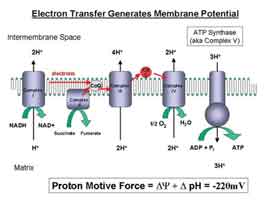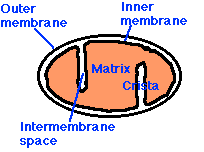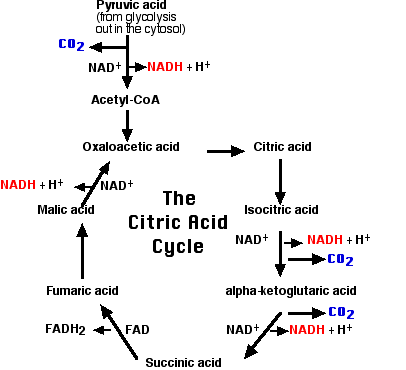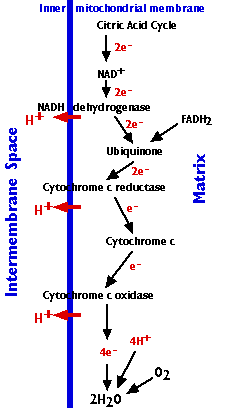 Respiration Respiration |
||
Cellular respiration is the process of oxidizing food molecules, like glucose, to carbon dioxide and water. The energy released is coupled to ATP for use by all the energy-consuming activities of the cell. 2 distinct evolutionary stages are still present:
In eukaryotes, glycolysis
occurs in the cytosol. . MitochondriaMitochondria are membrane-enclosed
organelles distributed through the cytosol of most eukaryotic cells.
Their main function is the conversion of the potential energy of food
molecules into ATP.
The Outer MembraneThe outer membrane contains many complexes of
integral membrane proteins that form channels through which a variety of
molecules and ions move in and out of the mitochondrion.
The Inner MembraneThe inner membrane contains 5 complexes of integral membrane proteins:
The MatrixThe matrix contains a complex mixture of soluble enzymes that catalyze the respiration of pyruvic acid and other small organic molecules. Here pyruvic acid is
The Citric Acid Cycle
Summary:
The electrons of NADH and FADH2 are transferred to the respiratory chain. The Respiratory Chain
and two freely-diffusible molecules
that shuttle electrons from one complex to the next. The respiratory chain accomplishes:
Chemiosmosis in mitochondriaThe energy released as electrons pass down the
gradient from NADH to oxygen is harnessed by the three enzyme complexes of
the respiratory chain to pump protons (H+)
against their concentration gradient from the matrix of the
mitochondrion into the intermembrane space (an example of
active transport). As their concentration increases there (which is the same as saying that the pH decreases), a strong diffusion gradient is set up. The only exit for these protons is through the ATP synthase complex. As in chloroplasts, the energy released as these electrons flow down their gradient is harnessed to the synthesis of ATP. The process is called chemiosmosis and is an example of facilitated diffusion. One-half of the 1997 Nobel Prize in Chemistry was awarded to Paul D. Boyer and John E. Walker for their discovery of how ATP synthase works.
|
 Mitochondria
have:
Mitochondria
have: 

 The
respiratory chain consists of 3 complexes of integral membrane proteins
The
respiratory chain consists of 3 complexes of integral membrane proteins
.gif)